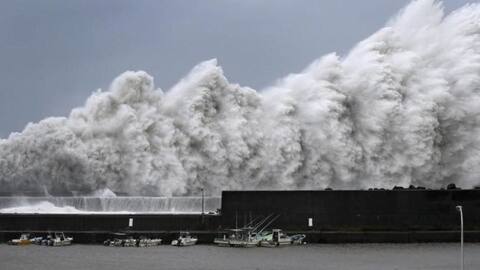Japan evacuates major airport as deadly typhoon wreaks havoc
What's the story
A major airport that was cut-off when a huge typhoon smashed through its sole access road was being evacuated today, as Japan grappled with the devastation caused by its most powerful storm in a quarter of a century.
Boats were ferrying stranded passengers from Kansai International Airport, one of Japan's busiest, after thousands had to spend the night in the partially-flooded facility.
Here's more.
Disastrous typhoon
Typhoon brings winds upto 216kmph overturning trucks, ripping roofs
At least ten people were killed, and hundreds more injured by Typhoon Jebi as it raked through the major manufacturing area around Japan's Osaka wrecking infrastructure and destroying homes.
Winds gusting up to 216km/h ripped off roofs, overturned trucks on bridges, and swept a 2,500-ton tanker into a bridge leading to the airport, the region's main international gateway, and a national transport hub.
Rescue
More than 2000 people awaiting rescue
The damage to the bridge left the artificial island cut off, stranding 3,000 travelers and additional staff overnight.
Runways were flooded as high waves washed into the facility yesterday, knocking out electricity and inundating buildings.
By today lunchtime (in Japan) several hundred people had been ferried to Kobe on a specially chartered boat, but more than two thousand were still awaiting rescue.
Information
Abe says govt working on reopening the airport
There was no indication yet when the airport might reopen. Japanese PM Shinzo Abe tweeted, "We'll do our best to get the airport functioning again." He said 2.4mn households had lost power in the storm, with service restored to only half by today morning.
Details
Nearly 16,000 people spent the night in shelters
Over 1.2mn people had been advised to leave their homes as Jebi approached the Kansai area. Around 16,000 people spent the night in shelters, media said.
Japan is regularly hit by powerful typhoons in the summer and autumn, many of which cause flooding and landslides in rural areas.
Jebi appears to have caused damage to the infrastructure on an unusual scale.
Damage
Jebi caused a lot of damage in Kyoto, Osaka area
In the tourist magnet of Kyoto, home to ancient temples and shrines, it brought down part of the ceiling of the main railway station, while in nearby Osaka, the high winds peeled scaffolding from a multi-story building.
Footage on NHK TV channel showed a 100-meter tall Ferris wheel in Osaka spinning furiously in the strong wind despite being switched off.
Past disasters
Jebi is still far from the deadliest Japan has seen
Businesses, factories, and schools in the affected area shut down while the storm barreled across the country, forcing the cancelation of hundreds of flights and ferry services.
The storm was still far from the deadliest Japan has seen in recent years.
In 2011, Typhoon Talas killed at least 82 people, while in 2013, a storm that hit south of Tokyo left 40 people dead.
